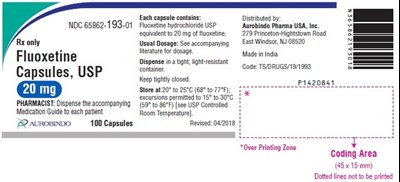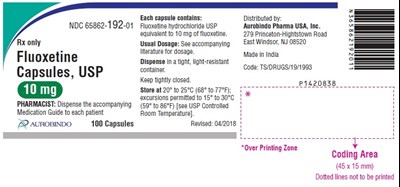Product Images Fluoxetine
View Photos of Packaging, Labels & Appearance
Product Label Images
The following 4 images provide visual information about the product associated with Fluoxetine NDC 65862-193 by Aurobindo Pharma Limited, such as packaging, labeling, and the appearance of the drug itself. This resource could be helpful for medical professionals, pharmacists, and patients seeking to verify medication information and ensure they have the correct product.
PACKAGE LABEL-PRINCIPAL DISPLAY PANEL - 20 mg (100 Capsules Bottle) - fluoxetine fig2

Each capsule contains Fluoxetine hydrochloride USP. The medicine is distributed by Aurobindo Pharma USA. It is a prescription drug and the recommended dosage should be followed as per the accompanying guide. The recommended storage temperature is 15°-30°C. Pharmacist instructions state that the medication guide should be dispensed along with the drug to each patient. The capsule container comes with 100 capsules and contains a printed code. Overprinting zone and dotted lines should not be printed.*
PACKAGE LABEL-PRINCIPAL DISPLAY PANEL - 40 mg (100 Capsules Bottle) - fluoxetine fig3

Fluoxetine Capsules are a medication distributed by Aurobindo Pharma USA, Inc. Each capsule contains 40 mg of fluoxetine hydrochloride USP. It is advised to dispense in a tight, light-resistant container and keep it at a controlled room temperature between 20°C to 25°C. The usual dosage should be referenced in the accompanying literature provided with the medication. The medication guide should also be provided to each patient by the pharmacist.*
* The product label images have been analyzed using a combination of traditional computing and machine learning techniques. It should be noted that the descriptions provided may not be entirely accurate as they are experimental in nature. Use the information in this page at your own discretion and risk.

